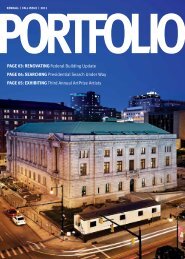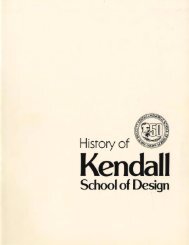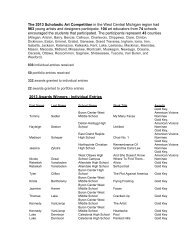Download - Kendall College of Art and Design
Download - Kendall College of Art and Design
Download - Kendall College of Art and Design
- No tags were found...
Create successful ePaper yourself
Turn your PDF publications into a flip-book with our unique Google optimized e-Paper software.
Left to right:Left Caption to right: one displayed in MetaPlusFolkerts’ Normal winning Roman poster design19 Caption Holes award two displayed winners (left in MetaPlus to right):Assistant Normal Roman Pr<strong>of</strong>essor Bob Marsh, senior KariThurman, Program Chair <strong>and</strong> AssistantPr<strong>of</strong>essor Below: Sam Blanchard, Adjunct Pr<strong>of</strong>essorNate Caption Lareau, one senior displayed Ryan in Donovan MetaPlusNormal RomanBelow:Caption two displayed in MetaPlusFrom left, Varnum attorney Mary Kay Shaver,Normal RomanKate Folkert <strong>and</strong> Pr<strong>of</strong>essor Ron RiksenCaption three displayed in MetaPlusNormal RomanHistoric Preservation Minor:Everything Old Is New AgainIf you believe that historic preservation is little more than keeping old buildings from being torn down,Adjunct Pr<strong>of</strong>essor Jennifer Metz will set you straight.Varnum Picnic Poster:A Riksen Class TraditionPr<strong>of</strong>essor Ron Riksen has been teachinggraphic design at <strong>Kendall</strong> for 40 years, <strong>and</strong>for 25 <strong>of</strong> those years, Riksen’s classes haveparticipated in a rite <strong>of</strong> spring: designingthe annual picnic poster for law firm VarnumRiddering Schmidt & Howlett.Riksen recalls how the poster project firstcame about. “At the time, Varnum SeniorPartner Dirk H<strong>of</strong>fius was Chairman <strong>of</strong> the<strong>Kendall</strong> <strong>College</strong> <strong>of</strong> <strong>Art</strong> <strong>and</strong> <strong>Design</strong> Board <strong>of</strong>Trustees. He is also a fan <strong>of</strong> the posters forthe Herman Miller Annual Picnic, a traditioninaugurated by designer Steve Frykholm. Dirkasked if my students might be interested indesigning a poster for the Varnum picnic, <strong>and</strong>I agreed to incorporate the project into one <strong>of</strong>my graphic design classes.”The poster’s requirements are fairly simple.It needs to include the date <strong>and</strong> location<strong>of</strong> the picnic <strong>and</strong> the firm’s name (recentlyshortened to “Varnum LLP”) <strong>and</strong> measure 12inches by 18 inches.“In some years, the poster has reflected thepicnic’s theme; in others, the poster mirrorsthe location,” says Riksen. “I always like totake students up to the second-floor hallwaynear the atrium where all the past posters aredisplayed, so they can see how the differentthemes <strong>and</strong> locations have been graphicallyrepresented over the years.” On a tour <strong>of</strong> thegallery, Riksen pointed to the first poster,which was composed <strong>of</strong> torn strips <strong>of</strong> bluepaper. “Many <strong>of</strong> the early ones were h<strong>and</strong>done,”he said. “We didn’t have computerswhen we first started. In a way, this gallery isa mini-timeline <strong>of</strong> graphic design.”The requirements may be simple, but therewards <strong>and</strong> recognition are big. Nearly 350families attend the picnic, <strong>and</strong> all are senta copy <strong>of</strong> the poster, which serves as the<strong>of</strong>ficial invitation; furthermore, the posteris framed <strong>and</strong> displayed in Varnum <strong>of</strong>ficesthroughout the state.This year’s picnic will be held at the Bl<strong>and</strong>fordNature Center, <strong>and</strong> the winning designer issophomore Kate Folkert. “Usually juniors orseniors win the competition,” Riksen said, “butthe judges were really drawn to Kate’s design.”When printed, Folkert’s poster, which, likeprevious winners, will have the creator’sname incorporated into the design, will takeits place in <strong>Kendall</strong>’s second-floor Varnumpicnic poster gallery.Metz teaches the classes needed to achieve a minor in Historic Preservation. Introduced to <strong>Kendall</strong> justseven years ago, the topic has become a favorite <strong>of</strong> interior design <strong>and</strong> art history majors. Yes, it doesinvolve visits to really old <strong>and</strong> not-so-old buildings – <strong>and</strong> a lot more.According to Metz, historic preservation seeks to preserve, conserve <strong>and</strong> protect buildings, objects,l<strong>and</strong>scapes or other artifacts <strong>of</strong> historic significance. “Preserving national historic l<strong>and</strong>marks – suchas Mount Vernon, George Washington’s home – has been taking place on a national level, but it wasn’tuntil the devastation <strong>of</strong> our historic resources during the ‘urban renewal’ <strong>of</strong> the 1960s that peoplebegan to realize the importance <strong>of</strong> saving more common historic buildings,” she says.Three classes toward the minor specifically address historic preservation: Introduction to HistoricPreservation, Historic Preservation History <strong>and</strong> Theory, <strong>and</strong> Historic Preservation Theory <strong>and</strong> Practice.Throughout the program, students learn how to evaluate buildings <strong>and</strong> styles; how to conduct archivalresearch into a building’s history; <strong>and</strong> what makes a building, area, neighborhood or district worthy <strong>of</strong>preservation. “Age, integrity, architectural type, rarity, <strong>and</strong> association with certain building trends orhistoric figures are just some <strong>of</strong> the criteria,” explains Metz.Field trips are an important part <strong>of</strong> the program. Recently, students went to the 1920s Felt Estate inSaugatuck, got a look at the 1949 “JA Building” on the corner <strong>of</strong> Division <strong>and</strong> Fulton in Gr<strong>and</strong> Rapids(the latest location <strong>of</strong> SiTE:LAB), toured Heritage Hill (one <strong>of</strong> the largest urban historic districts in thecountry), <strong>and</strong> were part <strong>of</strong> a lucky few who have been inside the old Federal Building to get a sneakpeek at the renovation progress.Metz is most <strong>of</strong>ten asked what one does with a minor in Historic Preservation. “It teaches anyoneanalytical thought <strong>and</strong> archival research techniques, <strong>and</strong> it gives interior designers an edge,” sheexplains. “Knowledge <strong>of</strong> a building’s history makes a huge difference when someone is deciding howto renovate a building, which, in this economy, more developers are doing instead <strong>of</strong> building new.<strong>Design</strong>ers are armed with historically accurate information instead <strong>of</strong> conjecture <strong>and</strong> guessing.”Combining historic preservation with sustainability knowledge elevates an interior designer above hisor her peers. “After all,” says Metz, “the highest form <strong>of</strong> green design is reusing an existing building.”She continues, “Unfortunately, people believe that a historic preservation commission sets down rulesthat tell owners what they can <strong>and</strong> cannot do, <strong>and</strong> makes it expensive to renovate or update their homeor business. Commissions gladly work with owners to find workable solutions that will maintain thevisual integrity <strong>of</strong> a building. And there are usually great tax incentives that can help <strong>of</strong>fset the costs.“The Federal Building is a perfect example <strong>of</strong> the value <strong>of</strong> historic preservation. It’s a wonderful spacewith a high degree <strong>of</strong> historic integrity, <strong>and</strong> it’s being remodeled as a ‘green’ building. It’s a greatexample <strong>of</strong> history meets sustainability. And ultimately, that’s what historic preservation is all about.”‘19 Holes’ Sculpture Entry Earns High ScoresIn a game where the objective is to score low, the <strong>Kendall</strong> Sculpture <strong>and</strong> Functional <strong>Art</strong> programscored big by winning the Curator’s Choice Award with their innovative entries in UICA’s “19 Holes.”Held at the Urban Institute for Contemporary <strong>Art</strong> during the month <strong>of</strong> March, 19 Holes is a mini-golfcourse designed by artists. It featured 19 extreme <strong>and</strong> inventive holes that took over UICA’s entirebuilding at 41 Sheldon Blvd. – two full floors plus walls, windows <strong>and</strong> ceilings.The SFA team won for their upside-down hole, “Blue Greens,” which was built with “grass” on theceiling, dangling flag pins, <strong>and</strong> a cloud-filled sky on the ground. And Adjunct Pr<strong>of</strong>essor Nate Lareauwon The People’s Choice Award for his hole, “Tone It Down!”KENDALL PORTFOLIO | SPRING ISSUE | 2011 9
















